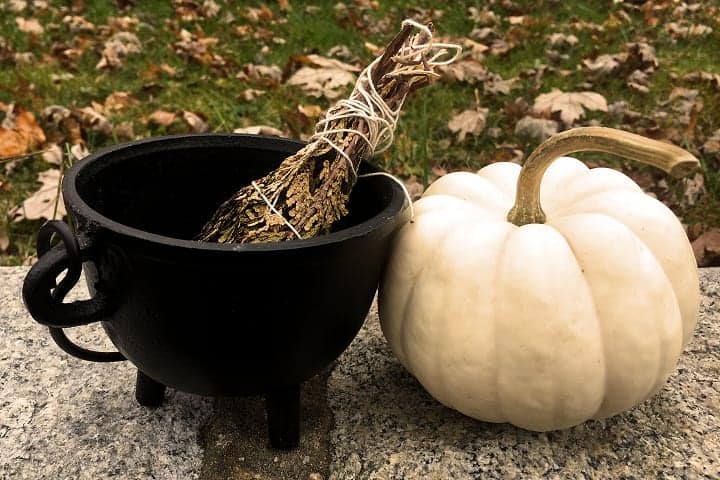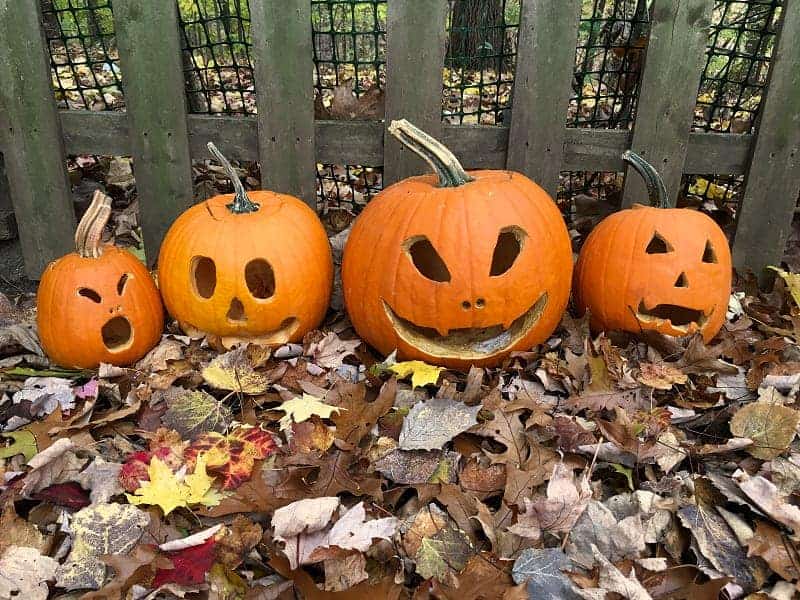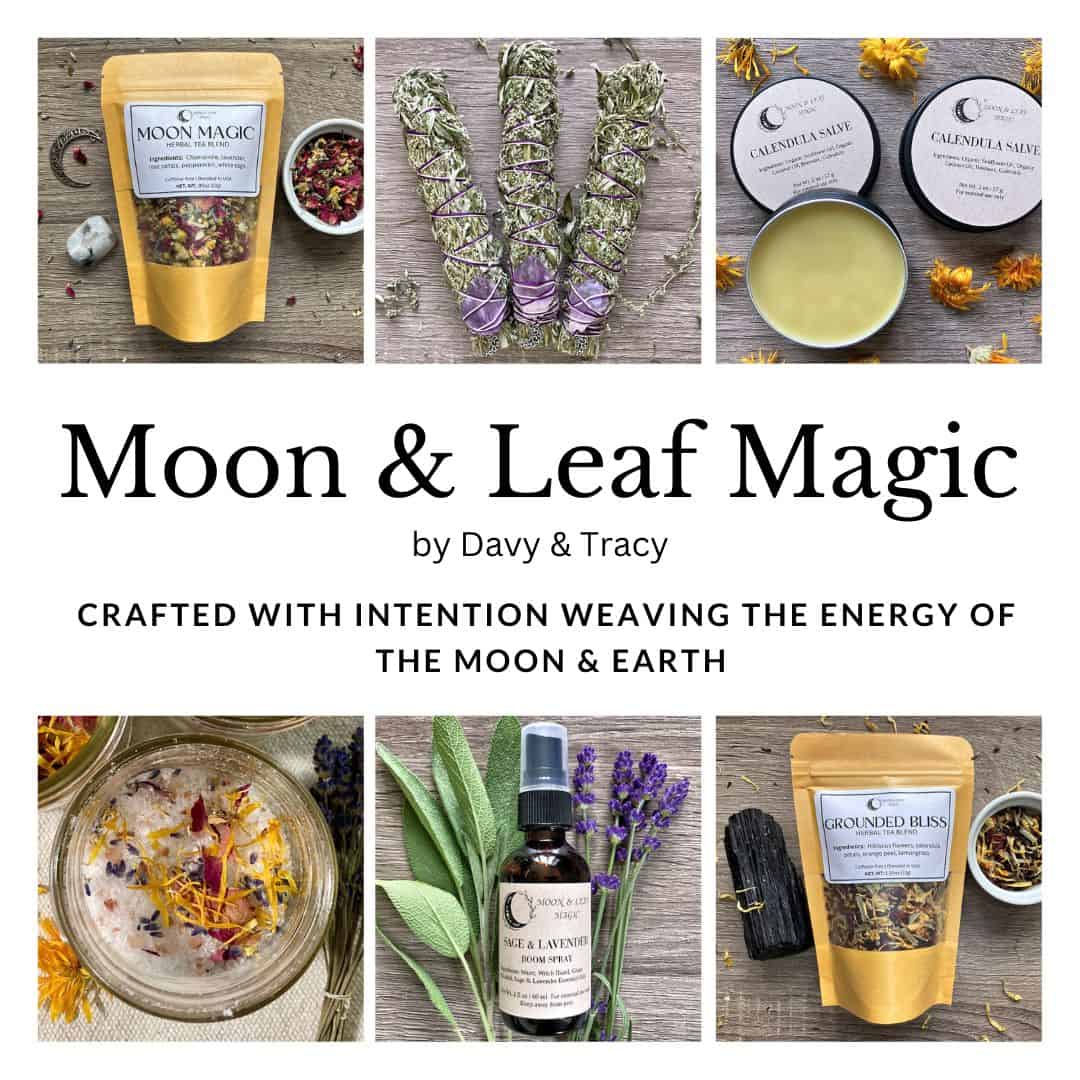
Date: October 31 – November 1
Samhain – usually pronounced sow-een or sow-in – is a cross-quarter festival in the pagan Wheel of the Year that falls between Mabon (autumn equinox) and Yule (winter solstice).
Samhain is an ancient Celtic festival said to have marked the end of summer and the final harvest that has morphed into the modern celebration of Halloween that most of us know today.
Themes & Meanings For Samhain
Samhain is the last harvest festival on the Wheel of the Year after Lughnasadh and Mabon.
Since we almost always get a hard frost just before Samhain, Tracy and I are busy this time of year gathering the last of the herbs from our garden.
Samhain is also a time for the remembrance and honoring of those we loved who have passed on.
It’s also a time when Tracy and I reflect on our ancestors, our heritage, and our place on the Tree of Life.
For some, Samhain begins the new year, and is often nicknamed the “Witches New Year”. For others, Samhain begins seasonal winter – a time of reflection and self-care to prepare for the coming new year.
The themes that Tracy and I reflect on during Samhain are:
Ancestors & Loved Ones Who Are No Longer With Us
Samhain has a long association with remembering the dead, and connecting with ancestors.
The ancient Celts believed that the veil between the world of the living and the realm of the dead was thinnest this time of year, leading to traditions of wearing masks, leaving offerings, and lighting fires to both appease restless spirits and repel them.
Tracy and I place pictures of family members who have passed away on our Samhain altar this time of year. Sometimes, we cook their favorite foods, or simply take a few moments in our day to keep their memory alive.

Our Place On The Tree Of Life
Beyond remembering loved one’s we knew that passed away, we also reflect on our ancestors – the distant, unknowable relatives who’s genes have passed through generations of individuals to shape our bodies, our personalities, and our instincts.
It’s really fascinating to think that hundreds, thousands, and tens of thousands of years ago, there were distinct individuals from who we inherited DNA living day-to-day lives we can barely imagine.
Beyond my human ancestors, I find it fascinating to reflect on my place on the Tree of Life.
The Tree of Life is a model used by biologists to show the relationship of all life on earth. We humans are only one leaf on one branch of a vast phylogenic tree. We share DNA and a planet with all living things.
Self-Care & Drawing Within
Samhain corresponds to the waning crescent moon – a point in the lunar cycle for self-care and drawing inward.
Releasing & Letting Go
Samhain, with its association with death and the afterlife, as well as its position at the waning half of the year, marks another opportunity to release and let go of what no longer serves you.
As the last sabbat before Yule, Samhain is the perfect time for endings.
Perhaps it’s time for you to end a bad habit, or a toxic relationship.
Maybe it’s time to release something that you’ve clung onto, but no longer serves you.
Samhain is the perfect time to work burial, composting, and transmutation into your rituals in preparation for being reborn by Yule.
Facing Our Fears
Halloween is synonymous with spookiness.
If you’re like me, you enjoy curling up on the couch with a hot mulled cider and a scary movie.
While Halloween is all about having fun with ghouls, goblins, and characters from horror movies, Halloween (and Samhain) is a great time to reflect on your fears – and face them.
Do something that gets you out of your comfort zone – or even scares you.
Read about something that gives you the creeps. I’ve faced my arachnophobia by reading several fascinating books on spiders.
Journal and reflect on what scares you about your own goals and life dreams. What “goblins” block the path between your intentions and the manifestation of your dreams?

Correspondences & Setting Up A Samhain Altar
One of the simplest ways to celebrate Samhain is to create a simple altar that features meaningful elements of the season.
Candles: Lighting candles is a great way to bring light into your home as the days grow shorter and the nights grow longer and colder.
My favorite candle colors to use at Samhain are white, orange, black, and purple. Additionally, autumn colors like brown and rust are good.
Crystals & Stones: Labradorite is my favorite crystal to work with during Samhain. Labradorite is said to enhance intuitive and psychic abilities, which make it the perfect stone to work with when the veil is thinnest at Samhain.
Apache Tear Obsidian is another crystal that can be helpful at Samhain – especially while remembering and honoring those who have recently passed. This stone is my go-to to assist with grief and loss.
Petrified wood and other fossils are also wonderful to work with during Samhain. The ancient energy of these objects help connect you to your past, your heritage, and intuit the messages passed through generations from your ancestors.
Additionally, amethyst, black tourmaline, smoky quartz, and obsidian are also favorite stones and crystals to work with at Samhain.
Herbs: Mugwort is my top Samhain herb as it is associated with intuition, divination, and dream work.
Cypress is associated with death, the afterlife, and/or the underworld, so it’s a good plant to use when letting go and releasing, or doing any ancestor work.
I incorporate cypress into Samhain smoke bundles, or diffuse cypress essential oil.
Other herbs to work with during Samhain include any other Artemisias (like Mugwort, wormwood), rosemary, valerian, sage, and catmint.
Oak leaves and acorns are particularly sacred at this time. Acorns represent potential and are the perfect item to work with during any Samhain intentions.
Flowers: Marigolds (tagetes) not only display perfect Samhain colors of dark reds, oranges, and yellows, they also represent death, the afterlife, and are associated with grief across many cultures.

Scents (Incense/Essential Oils): Mugwort, sage, clove, mint, cedar wood, copal, and frankincense.
Foods: Squash & pumpkin, nuts, seeds, apples, pears, cider, and bread
Altar Decor: Pumpkins, acorns, nuts, colorful leaves, bones, and skulls.
Suggested Rituals
You do not need to perform a fancy ritual to “properly” celebrate Samhain.
1) Create An Ancestor Altar
During Samhain, Tracy and I place pictures of loved ones who have passed on our fall altar.
You don’t need to get too elaborate with this, simply placing a few printed images amongst your autumn altar will do the trick. Or you can add some mementos that represent the people you honor.
The purpose of incorporating pictures of ancestors or loved ones who have passed on is to remind you to pause this time of year to reflect on and remember their legacy, and how their legacy and memory may live on within you.
2) Carve A Pumpkin
Carving a pumpkin is a traditional Halloween custom.
Turning a pumpkin into a Jack-o-Lantern can be a fun activity, but you can also inject some mindful, spiritual significance into the practice.
Carve a scary face on a pumpkin and set an intention for it to guard your home from negativity during the upcoming winter months.
You can also carve a face or other symbol that represents something you want to release between now and Yule (the winter solstice).
Set the pumpkin outside on Samhain, and then move it to an area where it can be left to compost. As your pumpkin composts (or is consumed by wild critters), allow the thing you want to be released compost into something new.

3) Stimulate Your Intuition
Divination is a common practice at Samhain, as many believe that communication with ancestors and spirits is easiest at this time of year.
While my own beliefs do not include spirits or telling the future, I regularly use divination tools such as tarot and oracle cards in my spiritual practice.
Take some time to do a tarot or oracle reading. However, don’t reach for the booklet or read up on the meanings of the cards. Just look at the cards without preconceived ideas of what each card means. Just look at the images and try to form your own connections.
Once again, Mugwort is a wonderful herb to work with this time of year. Either use a Mugwort smoke bundle during ritual, cast a circle with a Mugwort wand, sip some Mugwort tea, or dab on some Mugwort oil to absorb the intuition-boosting magickal energy of the plant.

